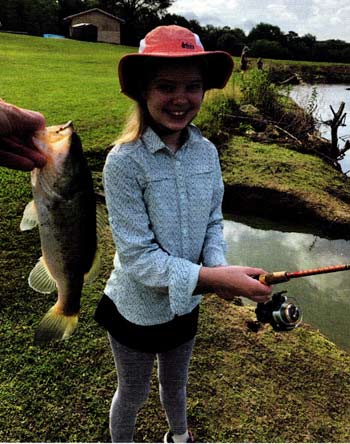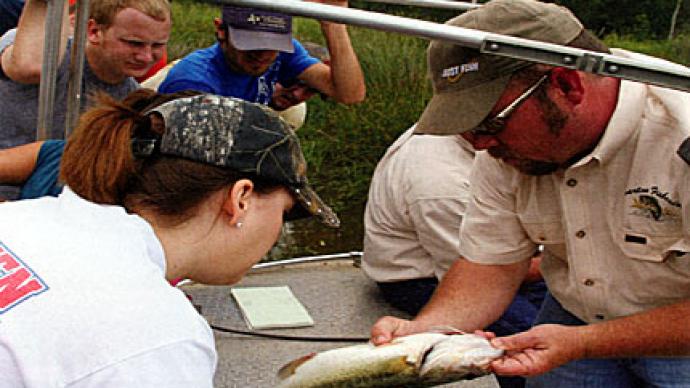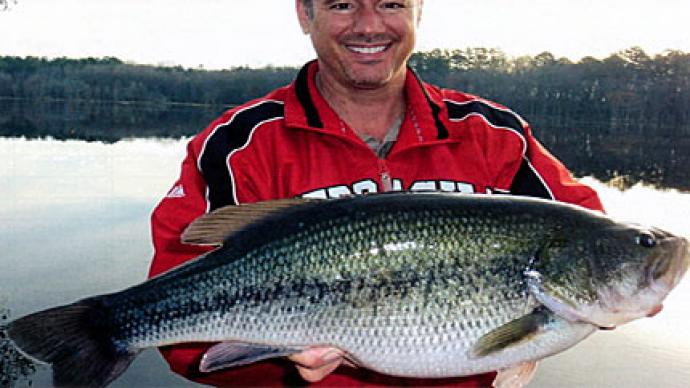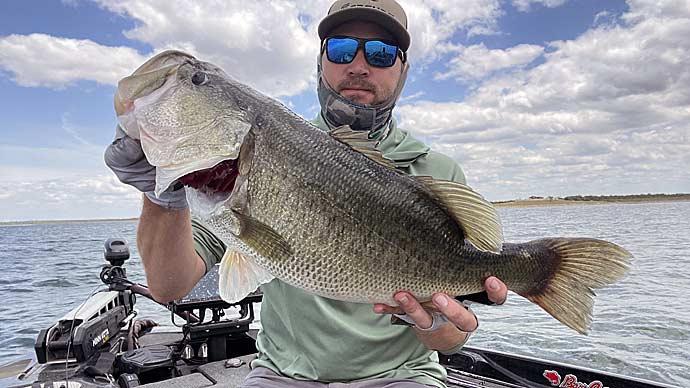
The afternoon sun had begun to cast long tree-shaped shadows out across the pond surface that only lightly rippled in the early May breeze. Grandpa tied a 1/32-ounce marabou jig on Lucy's miniature spin cast rod and carefully positioned it about 20 inches below the foam float. The light breeze caused the orange feathers and silver tinsel shimmer around the small size 10 hook. But Lucy paid little attention. She was distracted, focusing more on the dragonfly dancing along the water's surface than Grandpa's efforts.
"Lucy, pay attention," Grandpa said. "You need to push and hold the button and put the rod behind you like this, but keep holding the button." He gestured with his arms as if he was holding the small rod. "Then, swing it forward like this, and release the button when the rod passes over your head." He made the motion several times with his arms, emphasizing where to release. Lucy smiled and wondered if the dragonfly was a boy or a girl.
"Give it a try," Grandpa instructed as he placed the rod into Lucy's hands. Now, she was more attentive. She stepped forward, confidently pointed the rod behind her toward the trees, pushed the button, and swung the rod forward like she was going to cast to Jupiter. The float slammed the water with great force at her feet. "You need to let go of the button a little earlier," Grandpa suggested.
Lucy tried again. This time, she let go a little too early, and the float and jig made a high ark but landed about 10 feet offshore. "Good!" Grandpa exclaimed. "Now, start reeling in slowly." She did as Grandpa instructed. On the third crank of the reel, the float disappeared several inches below the water's surface, and Grandpa shouted, "He's got it. Reel it in!"
Lucy fought that 13-inch bass like it was a bluefin tuna. It shook, ran, jumped, and tried everything it could to free itself. Lucy reeled continuously. Finally, the bass tired and came in more willingly. Lucy walked backward, dragging the little fish to shore.
Grandpa lifted it from the water to a visibly different Lucy. Her eyes gleamed. She was focused. That fish was her entire world, and the smile on her face wrapped from ear to ear.
That day, Lucy perfected her casting technique and caught nearly a dozen small bass and several large bluegill. It was a great day that she will never forget. And no one got a hook stuck in them, although, from that point forward, Lucy was undoubtedly hooked on fishing.
So why did a 7-year-old, who had never fished before, have so much success with a little toy fishing rod? The answer is that she was fishing in a bass-crowded pond full of hungry fish.

We have spent many Pond Boss articles discussing how to avoid or correct bass overpopulation and crowding and how to manage trophy bass because that's what most people want from their ponds. But just because most pondmeisters desire double-digit bass potential doesn't mean it's the best approach for everyone.
Each year, I interact with hundreds of pond owners. I always begin our conversations with "What is your objective for the pond," or "What do you want from the pond?" Sure, many say 10+ pound bass, but a surprising number tell me they just want a place where their grandchildren can be guaranteed to catch fish. I steer these folks toward a bass-crowded pond.
She likely would not have caught anything if little Lucy were fishing in a well-managed pond. And if she did manage to get a 5-pound bass on the line, the odds of a new angler landing it on a toy rod are relatively low. Had she hooked a big fish only to lose it, she would likely have been unhappy in her first and potentially last fishing experience.
But in a bass-crowded pond, fish are smaller and more manageable. With most bass and bream, about 1 pound each, even a little SpongeBob SquarePants fishing rod can handle them. Lucy had great success catching these little bass because they were hungry, and she got a few slab bream to round out an exciting trip. She is, therefore, much more likely to go fishing again with Grandpa.
That is what taking children fishing is all about. If she sticks with it and becomes an avid angler, she will need to learn that fishing is not always that easy, but by then, she'll have the passion for angling and the skillset necessary to try more challenging situations. And at that time, maybe she'll be ready to try her luck at double-digit bass.
Bass-crowded ponds should be considered by pond owners who want to take children fishing or those who prefer big bream over bass. And they are easy to develop and maintain. They often develop on their own when management efforts, especially harvest is limited.
To encourage bass crowding, you must build and stock the pond usually but modify how you harvest bass. You just need to remove any bigger fish when caught instead of keeping the smaller bass, as we recommend when growing big bass. Beginning at least three years after stocking, take out every bass you catch that is 16 inches or larger. This will cause bass to stockpile at smaller sizes, slow their growth, and put intense predatory pressure on the bream.
You can combine this approach with a bream feeding program. Automatic feeders are best to ensure that bream are fed regularly and adequately, resulting in more and bigger bream. Feeders can be placed in several areas and should only be distributed during warmer months. Bluegill will do well on floating fish food is you feed enough that they consume it all in 5-10 minutes and feed fish at least four times a week.
Another way to improve the overall angling experience is strategically using fish habitat. Placing gravel beds and fish attractors close enough for children to cast will help increase their chances for success. Be sure to use fish attractors that reduce snagging potential, as nothing ruins a child's experience quite like being constantly snagged. This could be as simple as a field of PVC stakes beside a gravel bed.
Finally, because you are managing with children in mind, think about safety first. Provide safe access, like gradually sloping banks or piers with railing. Avoid areas where the pond bank drops steeply or has excessively deep water immediately offshore. A 3:1 slope in the water ensures that depth is adequate to allow fishing and avoid plant growth but still allows a child to climb out of the pond if they fall in. A dry place to sit and shade are also beneficial.
Little Lucy had a ball that day, but you don't need to be seven years old to enjoy a bass-crowded pond. Novice and avid anglers can have fun when catch rates are high and the time between bites is short. Even the most experienced anglers can test their skills by downsizing their gear or specializing, such as fly fishing. But even if that is not your thing, try putting your big bass gear away and taking a child to a bass-crowded pond for the afternoon. I promise you will be rewarded.
Dr. Wes Neal, Extension Professor at Mississippi State, serves as State Extension Fisheries Specialist and is passionate about educating the public on small lake and pond management. He is an avid researcher on farm pond management and sport fish genetics. Wes is the lead editor of Small Impoundment Management in North America, the only textbook on the subject. He loves to hunt and fish, wes.neal@msstate.edu.
Reprinted with permission from Pond Boss Magazine



